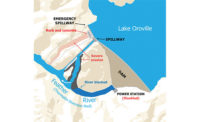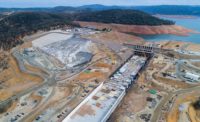On Sunday, Feb. 12, California officials ordered the immediate, mandatory evacuation of 188,000 residents from towns below the Oroville Dam. Two days later, when federal and state officials deemed the dam safe, the evacuation order was rescinded, and people were allowed to return to their homes. It isn't often that hundreds of thousands of people in the U.S. have to leave their homes because of worries about a catastrophic structural failure.
As an experienced civil engineer, I would like to make one point very clear: Oroville Dam was never in danger of failing. Because the Oroville Dam crest is 21 ft higher than the emergency spillway crest, the dam will never be overtopped.
| "As an experienced civil engineer, I would like to make one point very clear: Oroville Dam was never in danger of failing." |
But the California Dept. of Water Resources must take this opportunity to design a lasting replacement for the destroyed spillway. I'll explain why.
Located on the Feather River about 65 miles north of Sacramento, Calif., Oroville Dam is 770 ft high—the nation's tallest. Unlike Hoover Dam and Glen Canyon Dam, Oroville Dam is a zoned-earthfill structure.
Water can be released from the reservoir (Lake Oroville) behind the dam in four ways: power plant, river outlets, main spillway and emergency, or auxiliary, spillway. Because rock debris is damming up the powerhouse tailrace, the Oroville power plant is out of service. Due to various operational problems, the river outlets cannot be used. This leaves only the main spillway and the emergency spillway to let water out of the lake.
The main spillway is a 3,050-ft-long, concrete-lined chute, which extends from the flood-control outlet structure down to the Feather River. The gated headworks at the outlet structure has eight radial gates to meter water flow into the spillway chute. The main spillway is rated at 150,000 cubic ft per second (cfs).
The final component for releasing floodwaters from Lake Oroville is the emergency, or auxiliary, spillway. This is a concrete, 30-ft-high ungated overflow weir, with a crest length of 1,730 ft. When floodwater passes over this weir, the water tumbles down an unlined slope to the Feather River.
 |
| A relocated main spillway could be inserted between the existing spillway and the dotted lines in this simplified plan view of the dam and related structures. Image: Wikimedia Commons |
Heavy Rainfall Spikes Lake Levels
After large storms hit the Feather River tributaries in early February, Lake Oroville water levels began rising dramatically. Normally, this doesn’t happen until the snow melts and the spring rains bring additional water into the reservoir.
These early thunderstorms had a tremendous impact on the reservoir behind Oroville Dam. From February 6 to 11, high inflows entered Lake Oroville, with four days over 100,000 cfs. On February 8, the reservoir took in a whopping 240,000 acre-feet of water in a 24-hour period. Over the course of six days from February 6 - 11, Oroville Lake levels rose a gigantic 52 feet!
On February 11, the lake rose three feet and water started flowing over the emergency spillway shortly after 8:00 a.m. This was the first time that water had moved over the emergency spillway (Auxiliary Spillway) since Oroville Dam was built in 1967. Water continued flowing over the Emergency Spillway until 8:00 p.m. on February 12.
The California Dept. of Water Resources estimates that about 6,000 to 12,600 cfs of water passed over the emergency spillway on Saturday and Sunday (Feb. 11 and 12). (Through independent calculations, I verified that the spillway discharge capacity is 6,000 – 13,000 cfs.) When compared with the main spillway releasing 100,000 cfs, “this is a drop in the proverbial bucket.”
As the water made its way down the steep slope to the Feather River, significant erosion took place. Huge canyons were carved out of the hillside and sections of the boat ramp access road were destroyed.
The Spillway Problems
Of particular concern was the erosion that took place at the toe of the emergency spillway. After the emergency spillway stopped flowing, engineers could assess the damage that took place on Saturday and Sunday. Holes near the 30-ft-high emergency spillway were readily apparent.
Some people feared that this concrete weir would be undermined and fail, thereby releasing a 30-ft-high wall of water onto the towns below the dam. This is why the authorities called for the immediate and mandatory evacuation.
 |
| Henry W. Burke |
To prevent future damage when using the Emergency Spillway, workers armored the slopes with rocks and concrete.
The problems with the main spillway were brought to light on February 7, when a large hole appeared in the spillway concrete slab, near the location of an earlier patch job. By February 10, the spillway crater had grown to 500-ft. long x 300-ft. wide x 45-ft. deep.
In the process, the concrete side wall collapsed and was washed away. As the crater got larger, more and more water shot out of the spillway and carved a new canyon that carries the water down to the Feather River. Depending on the flow volume, most of the water leaves the spillway chute at the location of this large crater.
What caused the failure of the main spillway concrete slab?
Main Spillway Solutions
On February 14, I sent a letter to Dept. of Water Resources, in which I suggested that the concrete in the main spillway chute had been destroyed by powerful “cavitation” forces. Cavitation can occur in spillways and tunnels when high-velocity water encounters irregularities in the concrete surface. At these locations, cavitation creates high-pressure shock waves capable of destroying solid concrete. Proper aeration of the water flow can minimize the harmful effects of cavitation.
The department should immediately design the main spillway replacement so that construction can take place this summer, during the low-flow season. The department has placed the rebuilding cost of the Main Spillway at about $200 million.
Besides tough site conditions, the biggest obstacle could be the need to handle main spillway water flows during construction. How will the contractor divert 60,000 – 100,000 cfs of high-velocity water around the repair site during construction? Because this will be extremely difficult, construction must be pursued on a “24/7” basis to accomplish all work in the dry season.
A logical alternative is to design a new main spillway chute to replace the 50-year-old spillway. Of course, anti-cavitation measures would be incorporated into the new design, along with new energy dissipation features at the Feather River.
The new spillway chute would have an alignment almost parallel with the existing spillway, a short distance to the northwest. Most of the construction work could be accomplished even if the existing spillway has to carry water. When the new spillway chute is built, it will be tied into the existing spillway near the gated headworks with a training wall at a very shallow angle.
On February 27, the Dept. of Water Resources closed the gates in the Main Spillway. With no water flowing, people could see how rushing water can utterly destroy a weakened concrete spillway. Roughly half of the spillway’s length has been reduced to short stretches of concrete, rubble and huge canyons.
The department kept the Main Spillway gates closed from February 27 to March 17. During this period, contractor crews removed about 1.25 million cubic yards of rock and concrete debris from the Feather River, allowing partial operation of the powerhouse turbines. Beginning March 17, the department is releasing around 50,000 cfs of water down the damaged main spillway to lower Lake Oroville water levels.
Because of the heavy destruction, total replacement of the main spillway in a new location becomes even more attractive -- and that is the course of action I urge the department to take.




Post a comment to this article
Report Abusive Comment